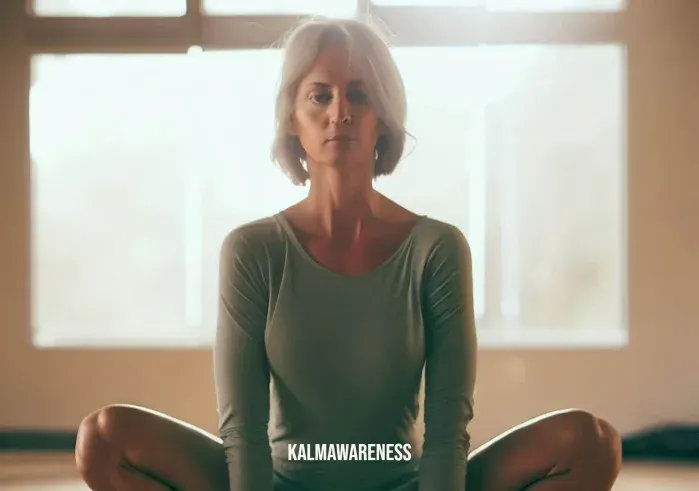Exploring the yoga squat pose benefits
- Pose Name | Yoga Squat Pose
- Original Name | Malasana
- Difficulty Level | Intermediate
- Pose Category | Standing Yoga Poses
- Exercise Duration | For beginners: Hold for 30 seconds to 1 minute. For advanced practitioners: Hold for 1 to 2 minutes.
Yoga is a time-honored practice that not only nurtures the body but also brings harmony to the mind and soul. Among the myriad of yoga poses, the Yoga Squat Pose, also known as Malasana, stands out for its incredible benefits and versatility. In this article, we’ll explore the enriching aspects of this pose and delve into its impact on your physical and mental well-being.
Why Yoga Squat Pose is a Must-Have in Your Yoga Repertoire
The Yoga Squat Pose is not just an asana; it’s a grounding experience that connects you with the earth and your inner self. This beautiful yoga pose helps to open up your hips, stretch your lower back, and tone your lower body muscles. Let’s dive into the remarkable benefits it offers:
1. Strengthens the Lower Body
As you settle into the Yoga Squat Pose, you’ll feel your leg muscles engaging. This pose particularly targets the quadriceps, hamstrings, and calf muscles, giving them a gentle yet effective workout. Regular practice can lead to increased leg strength and stability, essential for maintaining balance in your daily activities.
2. Hip Flexibility and Mobility
The deep squat position in this pose helps to release tension in the hip flexors and increases their flexibility. This is especially beneficial for individuals who spend long hours sitting or have tight hips. With consistent practice, you’ll notice enhanced hip mobility and a greater range of motion.
3. Aids Digestion
Yoga Squat Pose stimulates the abdominal organs, including the digestive system. This gentle compression massages the organs, promoting better digestion and relieving digestive issues like bloating and constipation. Incorporating this pose into your post-meal routine can work wonders for your digestive health.
4. Balances the Nervous System
The mindful and steady breathwork in Yoga Squat Pose helps activate the parasympathetic nervous system, promoting relaxation and reducing stress. This can be a powerful tool for calming the mind and finding a sense of inner peace amid life’s hustle and bustle.
5. Prepares for Meditation
Malasana is an excellent pose to prepare your body for seated meditation. It helps to lengthen and straighten the spine, ensuring a comfortable and aligned posture for an extended meditation session. By opening up the hips and grounding yourself, you create a stable foundation for a more profound meditative experience.
Embarking on the Yoga Squat Pose Journey
Now that you’re acquainted with the wonderful benefits of Yoga Squat Pose, it’s time to embrace it in your practice. Let’s go through a step-by-step guide to help you flow into this posture gracefully:
- Start in Mountain Pose: Stand with your feet hip-width apart, shoulders relaxed, and arms by your sides.
- Exhale and Bend Your Knees: Gradually lower your body into a squat position, keeping your feet flat on the mat. Bring your palms together at your heart center, using your elbows to gently push your knees outward.
- Find Your Balance: Shift your weight slightly forward, keeping your back straight and chest lifted. Engage your core to maintain stability.
- Lengthen Your Spine: Elongate your spine from the tailbone to the crown of your head. Feel your body rooting into the ground while reaching upward.
- Breathe and Hold: Take deep breaths as you hold the pose for the desired duration. For beginners, aim for 30 seconds to 1 minute, and for advanced practitioners, 1 to 2 minutes.
- Release Slowly: To come out of the pose, exhale and bring your hands down to the mat. Straighten your legs and return to a standing position.

Yoga Squat Pose Benefits and Variations for All Levels
Welcome back to our enlightening journey through the Yoga Squat Pose cluster! In this chapter, we’ll explore the numerous benefits this pose brings to your overall well-being. We’ll also address who should refrain from practicing this pose and introduce variations suitable for different levels of experience.
Yoga Squat Pose: A Bounty of Benefits
The Yoga Squat Pose, or Malasana, goes beyond its physical aspects and extends its goodness to your mental and emotional realms. Let’s delve into the marvelous benefits it offers:
1. Stimulates the Sacral Chakra
In yoga, the sacral chakra is associated with creativity, passion, and sensuality. As you sink into the Yoga Squat Pose, you activate and stimulate this energy center, allowing the flow of creativity and passion to flourish. It helps you connect with your inner self and unleash your authentic self-expression.
2. Tones and Strengthens the Pelvic Floor
Regular practice of this pose is beneficial for both men and women, as it targets and tones the pelvic floor muscles. A strong pelvic floor is essential for supporting the organs in the pelvic region and promoting urinary and reproductive health.
3. Encourages Natural Birthing Position
For expectant mothers, the Yoga Squat Pose is highly beneficial. It helps to open up the pelvis and encourages the baby to descend into the birth canal in a more favorable position. Additionally, it eases tension in the lower back, which can be especially relieving during pregnancy.
4. Enhances Digestive Fire
By compressing the abdomen, this pose stimulates the digestive organs, improving digestion, and supporting the metabolic process. It aids in better nutrient absorption and detoxification, leading to improved overall gut health.
5. Improves Posture and Balance
Practicing Malasana regularly helps to strengthen the muscles in your back and core, contributing to improved posture and overall stability. This, in turn, can prevent backaches and injuries related to poor posture.
6. Boosts Emotional Release
As you surrender into the deep squat position, you allow emotions and tensions stored in the hips and lower back to be released. This emotional release can be liberating, leading to a greater sense of emotional well-being and a clear mind.
7. Cultivates Patience and Mindfulness
Yoga Squat Pose is not always the easiest to master, and this journey of practicing patience and mindfulness is what makes the pose so special. It teaches you to embrace the process and honor your body’s limitations with grace and acceptance.
8. Promotes Circulation
The squatting position improves blood flow to the lower body and pelvic region, enhancing circulation and reducing the risk of swelling and discomfort.
Who Should Avoid Yoga Squat Pose?
While the Yoga Squat Pose offers incredible benefits, it may not be suitable for everyone. If you have any of the following conditions, it’s best to avoid this pose:
- Knee or Ankle Injuries: Individuals with knee or ankle issues should be cautious with this pose to prevent further strain on these areas.
- Lower Back Pain: If you experience chronic lower back pain, consult with a yoga instructor or healthcare professional before attempting this pose.
- Pregnancy Complications: Pregnant women should avoid this pose if they have complications or if it feels uncomfortable.
- Digestive Disorders: Individuals with severe digestive disorders like irritable bowel syndrome (IBS) should refrain from this pose to avoid aggravating their condition.
Variations for All Levels
1. Beginners Variation: Supported Malasana
For beginners, this variation provides additional support and stability:
- Stand facing a wall with your feet about hip-width apart.
- Lower into the squat position, using the wall for support by placing your hands on it.
- This will help you find balance and gradually build strength and flexibility.
2. Intermediate Variation: Garland Pose Flow
This dynamic variation adds movement to the Yoga Squat Pose:
- From a standing position, lower into Malasana, keeping your palms together at your heart center.
- As you inhale, rise up and extend your arms overhead.
- Exhale, return to Malasana, and repeat the flow for several rounds.
3. Advanced Variation: Crow to Malasana Transition
For those seeking an advanced challenge:
- Begin in Crow Pose (Bakasana) with your knees resting on your triceps.
- Slowly transition into Malasana by lowering your feet to the ground while maintaining balance.

Unveiling the History and Spiritual Significance of Yoga Squat Pose
In this final chapter of our captivating Yoga Squat Pose series, we embark on an exploration of the pose’s rich history and delve into its spiritual significance. Additionally, we’ll provide valuable tips to help you optimize your practice, avoid common mistakes, and discover modifications for individuals with injuries or limited flexibility. Let’s dive into the ancient roots of this empowering yoga pose!
The Ancient Origins of Yoga Squat Pose
Yoga Squat Pose, or Malasana, has its roots in traditional Hatha yoga. It is believed to have originated in India, where ancient yogis incorporated various squatting postures into their practice. The term “Malasana” is derived from the Sanskrit words “mala” (garland) and “asana” (pose), signifying the resemblance of the pose to a garland or flower bud.
Over the centuries, this pose has been passed down through generations of yogis, evolving as an integral part of yoga sequences. It was primarily practiced to aid in digestion, cleanse the body, and prepare the mind for meditation.
Embracing the Spiritual Essence of Malasana
Beyond its physical benefits, Yoga Squat Pose holds deep spiritual significance. The squatting position connects us with the earth, symbolizing grounding and stability. As we root down into the ground, we connect with our primal essence and acknowledge the fundamental interconnectedness of all living beings.
The pelvis, which is the center of gravity in this pose, represents the sacral chakra – the energy center associated with emotions, creativity, and sensuality. Practicing Malasana helps to balance and activate this chakra, fostering emotional release and igniting our creative potential.
Moreover, the squatting posture in Malasana resembles that of a humble prayer, inviting introspection and reflection. It encourages us to let go of ego and surrender to the present moment, embracing a sense of unity with ourselves and the universe.
Tips for Deepening Your Yoga Squat Pose Practice
To make the most out of your Yoga Squat Pose experience, consider these tips:
- Warm-Up: Prior to practicing Malasana, engage in a gentle warm-up to prepare your hips and lower back for the deep squat. Dynamic movements and hip-opening stretches can be particularly beneficial.
- Relax and Breathe: As you settle into the pose, focus on your breath. Allow it to flow naturally, bringing a sense of calmness and mindfulness to your practice.
- Use Props: If you find it challenging to maintain balance or keep your heels on the ground, use props such as blocks or a folded blanket under your heels for support.
- Engage Core Muscles: Strengthen your core muscles to stabilize the posture and prevent rounding of the lower back.
Common Mistakes to Avoid
While Yoga Squat Pose offers numerous benefits, it’s essential to practice it mindfully and avoid common mistakes:
- Rounding the Back: Maintain a straight back throughout the pose to protect your spine and avoid strain on the lower back.
- Overextending Knees: Be gentle on your knees and avoid pushing them too far forward. Ensure they align with your ankles.
- Tension in Shoulders: Keep your shoulders relaxed and away from your ears. Avoid unnecessary tension in this area.
Modifications for Individual Needs
For individuals with injuries or limited flexibility, modifying the Yoga Squat Pose can be empowering. Consider these variations:
- Using Support: Place a cushion or yoga block under your hips to alleviate pressure on the knees and ankles.
- One-Legged Variation: If squatting on both feet is challenging, try a one-legged variation by extending one leg forward while squatting on the other.
Poses that Complement Yoga Squat Pose
To create a well-rounded yoga practice, consider incorporating these complementary poses:
- Garland Pose Flow: Flowing between Yoga Squat Pose and standing Garland Pose (Utkata Konasana) helps to build strength and flexibility in the lower body.
- Seated Forward Bend: Follow up your Malasana practice with a seated forward bend (Paschimottanasana) to stretch the hamstrings and lower back.
- Child’s Pose: Transitioning into Child’s Pose (Balasana) after Malasana allows for a gentle release and relaxation.
Embrace the Journey of Malasana
As you continue your journey in yoga and explore the wonders of Yoga Squat Pose, remember that each pose is an opportunity to connect with your body, mind, and spirit. Malasana is not just a physical pose; it’s an invitation to embrace your authenticity, find balance, and discover the beauty within.
So, keep practicing, keep exploring, and above all, keep shining on your yoga mat and beyond!
Note: Thank you for joining us in this inspiring journey through the Yoga Squat Pose cluster. We hope these articles have illuminated your understanding and ignited your passion for yoga. As you continue your yoga practice, remember to approach each pose with an open heart and a curious mind. May your yoga journey be filled with growth, mindfulness, and blissful connections.




